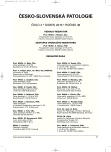Forensic Interpretation of Postmortal Ethanol Neogenesis in Blood Samples of Cadaverously Decomposed Bodies
Authors:
Ľ. Straka 1; F. Novomeský 2; J. Krajčovič 2; F. Štuller 2; A. Brzobohatá 3; T. Vojtíšek 3
Authors place of work:
Súdno-lekárske pracovisko ÚDZS, Martin
1; Ústav súdneho lekárstva a medicínskych expertíz JLF UK a MFN, Martin
2; Ústav soudního lékařství LF MU, Brno
3
Published in the journal:
Soud Lék., 55, 2010, No. 2, p. 18-21
Summary
There is no real possibility for detail knowledge of postmortal changes of blood alcohol concentration in the near future, so that it is necessary to comment alcoholaemia with special aspect on empirical practice. Potential use of alternative (more resistant to putrefaction) body fluid or tissue can help to distinguish ratio of endogenous and exogenous ethanol. It seems that using of vitreous (eventually urine) is the best way to avoid desinterpretation mistakes of alcoholemia in cadavers. In cases where these fluids are missing we are not able to comment alcoholaemia of saprogenic blood.
Key words:
ethanol – endogenous ethanol – ethanol production post-mortem – ethanol fermentation
Zdroje
1. Appenzeller, B.M., Schuman, M., Wennig, R.: Was a child poisoned by ethanol? Discrimination between ante-mortem consumption and post-mortem formation. In: Int J Legal Med., 2008, 122 (5), s. 429–434.
2. Buomba, V.A., Ziavrou, K.S., Vougiouklakis, T.: Biochemical pathways generating post-mortem volatile compounds co-detected during forensic ethanol analyses. In: Forensic Science International, 2008, vo. 174 (2-3), s. 133–151.
3. DiMaio, V.J., DiMaio, D.: Forensic Pathology, 2-nd edition, Washington, D.C., CRC Press, 2001, s. 515–520.
4. Dolinak, D., Matshes, E., Lew, E.: Forensic pathology - principles and practise, Oxford, Elsevier Ltd., 2005, 690 s.
5. Ferrari, L.A., Triszcz, J.M., Giannuzzi, L.: Kinetics of ethanol degradation in forensic blood samples. In: Forensic science international, 2006, vol. 161 (2–3), s. 141.
6. Haglund, W.D., Sorg, M.H.: Forensic Tapohonomy – The Postmortem Fate of Human Remains. Boca Raton, CRC Press, 1997, s. 93 - 104.
7. Hirt, M.: Alcoholism: A Historical and General View. In: Protialkoholický Obzor, 23, 1988, č. 5, s. 275–279.
8. Hirt, M.: Současné náhledy na metabolismus etanolu. In: Soud. Lék., 39, 1994, č. 3, s. 22 - 23.
9. Hirt, M., Lacina, P., Krejzlík, Z., Márz, J.: Etanol, s. 529–538, In: Kolektiv autorů: Soudní lékařství, Grada Publishing, Praha 1999, 606 s.
10. Hunsaker, D.N., Hunsaker, J.C.: Postmortem Alcohol Interpretation - Medicolegal Considerations Affecting Libiny and Deceased Persons. In: Tsokos, M.: Forensic Patology Rewiews, Totowa, Humana Press, 2004, s. 307–341.
11. Hunt, W. A.: Alcohol and biological membranes, New York, London, The Guilford Press, 1985, s. 14–144.
12. Chaturvedi, A.K., Roe, B.A., Kupfer, D.M., Canfield, D.V.: PCR - Based Identification od Postmortem Microbial Contaminants - A Preliminary Study. In: Journal of Forensic Sciences, 1999, Volume 44, Issue 3.
13. Jansson-Nettelbladt, E., Meurling, S., Petrini, B., Zmolin, J.: Endogenous ethanol fermentation in a child with short bowel syndrome. In: Acta Paediatrica, 2006, Vol. 95 (4), s. 502–504.
14. Johnson, R.D:, Lewis, R.j., Angier, M.K., Vu, N.T.: The Formation of Ethanol in Postmortem Tissues. Springfield, National Technical Information Service, 2004, s. 1–10.
15. Karch, S. B.: Drug Abuse Handbook, Washington, D.C., CRC Press, 2nd edition, 2006, s. 376–395.
16. Kugelberg, F.C., Jones, A.W.: Interpreting results of ethanol analysis in postmortem specimens: a review of literature. In: Forensic Sci Int., 2007, 165 (1), s. 10–29.
17. Logan, B.K., Jones, A.W.: Endogenous ethanol (auto-brewery syndrome) as a drunk-driving defence challenge. In: Med Sci Law, 2000, 40 (3), s. 206–215.
18. Mayer, R.G.: Embalming: history, theory, and practice. The McGraw-Hill Comp., 2006, s. 1–25.
19. Payne - James, J., Byard, R.W., Corey, T.S., Henderson, C.: Encyclopedia of forensic and legal medicine, Oxford, Elsevier Ltd., 2005, s. 21–58.
20. Pitr, K.: Lékařské vyšetřování a posuzování alkoholického ovlivnění, Plzeň, 1987, s. 6–27.
21. Stanovisko Slovenskej súdno-lekárskej spoločnosti k problematike prepočtov koncentrácie etanolu v krvi, Príloha č. 1 – Pokyny pre stanovenie etanolu, Bratislava, 3. schôdza výboru SSLS, 2003. In: Soud. Lék., 49, 2004, č. 2, s. 22–24.
22. Takayasu, T., Ohsima, T., Tanaka, N., Maeda, H., Kondo, T., Nishigami, J., Nagano, T.: Postmortem degradation of administered ethanol-d6 and production of endogenous ethanol: experimental studies using rats and rabbits. In: Forensic Science International, 1996, 76 (2), s. 129–140.
23. Tesař, J.: Soudní lékařství, 3. doplněné vydání, Praha, Avicenum, 1985, s. 134.
24. Yajima, D., Motani, H., Kamei, K., Sato, Y., Hayakawa, M., Iwase, H.: In: Forensic Science Int., 2006, Volume 164 (2), s. 116–121.
25. Ziavrou, K., Boumba, V.A., Vougiouklakis, T.G.: Insight into the Origin of Postmortem Ethanol. In: Int. J. of Tox., 2005, Vol. 24 (2), s. 69–67.
Štítky
Patológia Súdne lekárstvo ToxikológiaČlánok vyšiel v časopise
Soudní lékařství

2010 Číslo 2
Najčítanejšie v tomto čísle
- Forenzná interpretácia postmortálnej neogenézy etanolu v krvných vzorkách z kadaverózne dekomponovaných tiel
- Forenzne-antropologická expertíza termicky poškodeného tela historicky významnej osoby – prínos k zachovaniu historického dedičstva
- Pitevní nález otravy carbamazepinem
- J. L. Pilgrim, D. Gerostamoulos, O. Drummer: „Death Involving Serotonergic Drugs“. TIAFT Bulletin 39/3, 2009, 20-25.
